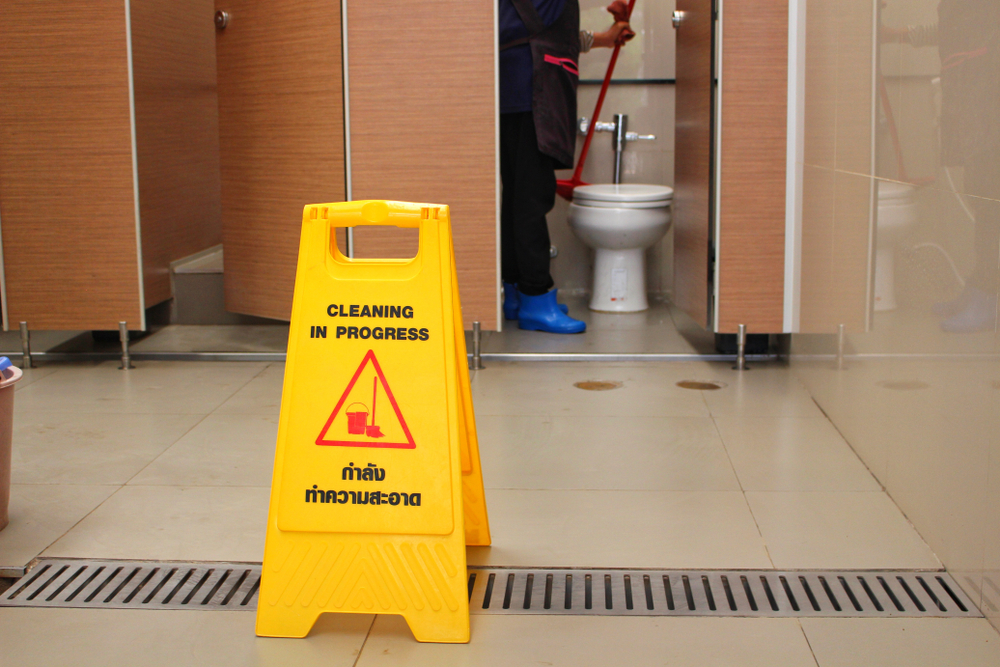Restrooms are often one of the smallest areas in a facility, yet they often present the biggest challenge for facility managers. This is because restrooms see frequent use and their level of cleanliness can make or break a visitor’s first impression of a facility. Plus, it’s not feasible to clean restrooms after each guest. A visible mess or odor can occur within a span of several minutes and negatively impact the next guest’s experience.
According to the 2020 In-House/Facility Management Benchmarking Survey from Cleaning and Maintenance Management, restrooms are the most problematic surface/area for facility managers across all types of facilities, by more than double. From toilet clogs to overflowing trash receptacles to slippery floors, there are many issues that can arise. Given that 90% of U.S. adults think employers should deep clean workplace restrooms regularly, cleaning teams need to dedicate a significant focus of the cleaning program to restroom maintenance.
Germs, Bacteria, Viruses – Oh My!
Viruses and bacteria lurk on high-touch bathroom surfaces such as doorknobs, countertops, soap dispensers and toilet handles. According to a study in Applied and Environmental Microbiology, 77,000 distinct bacteria and viruses can exist in restrooms. These bacteria are more likely to spread after toilets are flushed because fecal matter is distributed into the air in aerosol form, commonly referred to as “toilet plume.” It then contaminates surfaces and potentially guests’ hands, thereby enabling these germs to spread from person to person.
Now more than ever, it’s vital to pay close attention to restroom maintenance. In June 2020, a survey from Tork revealed that 73% of people in North America felt more unsafe going to facilities with unhygienic public restrooms than before the pandemic. Now that the public is more aware of the risks associated with a lack of cleanliness, facility managers and their teams need to prioritize keeping these smaller spaces clean to ensure the biggest impact on guest satisfaction.
Strategies for Spectacular Restrooms
All aspects of restrooms must be considered when developing your cleaning strategy. Consider the following best practices to make your restrooms memorable:
Invest time in training employees.
Training employees is crucial for achieving the highest level of cleanliness and maintaining consistency across an entire facility or even several buildings. Many people incorrectly assume that the toilet is a restroom’s most unsanitary surface. In fact, many areas harbor high numbers of bacteria. Thus, it’s essential to train employees to clean and disinfect the less obvious surfaces, such as restroom stall walls and grab rails, which can become contaminated with pathogens. They should also learn the proper order for cleaning – top to bottom – to avoid cross contamination.
Set and follow a cleaning schedule.
Restrooms are high-traffic spaces that can harbor pathogens across many different surfaces. Germs can spread more easily if people are not practicing proper hand hygiene in these environments. The 2021 Healthy Handwashing Survey from Bradley Corporation found that nearly half (48%) of Americans admit to having simply rinsed their hands with water instead of washing with soap. Having a set schedule in place for cleaning, disinfecting and restocking restrooms can help limit the spread of germs by ensuring that guests have enough toilet paper, soap and paper towels to uphold cleanliness. Develop the schedule based on the facility’s typical traffic patterns. While some facilities are still experiencing lower-than-normal occupancies during the pandemic, restrooms must always be clean and ready for guests.
Incorporate sustainable cleaning chemicals.
The COVID-19 pandemic caused supply chain disruption and resulted in many cleaning professionals using products with which they were unfamiliar. Coupled with the fact that many facilities are cleaning more frequently, it’s important to understand their composition, as toxic ingredients and fragrances can negatively impact workers and restroom guests. Investing in an on-site generation (OSG) system that creates non-irritating solutions with just water, salt and electricity eliminates supply issues and enhances safety. The OSG system produces electrochemically activated solutions (ECAS) that are effective against pathogens, safe for the environment and can replace the majority of chemicals required to maintain a facility.
Clean Restrooms Create a Better Facility
Maintaining clean restrooms is essential for creating safe environments for facility occupants. By thoroughly training employees, regularly cleaning and disinfecting, restocking supplies as needed and implementing sustainable cleaning chemicals, you can control the presence and spread of germs and give restroom guests a great experience at every visit.
Keeping restrooms clean protects your brand reputation and your facility’s occupants. Contact us to learn how we can support your cleaning needs and follow us on LinkedIn and Facebook for updates.



